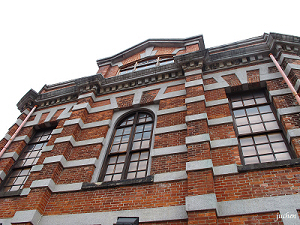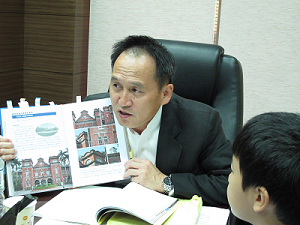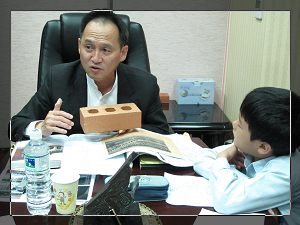
Interview of Want Taiwan Cultural Environment Foundation (Part II)
|
|
|
Interviewee: Architect, Mr. Zhi-Song Lin |
|---|
|
Q1: What are the
characteristics of the red building of Rixin? Why do
we want
to preserve it? (Shao-Hua) A1: From 1895 to 1945, during the Japanese colonial period, cities and buildings in Taiwan were immensely influenced by Japan. Our
presidential building was built in 1919, where the
architectural style was to use red bricks for buildings. Although the red building of Rixin was built around the same period of time, for it was a school rather than governmental buildings, there werenˇ¦t as many decorations on the building. The architectures of an era represent the actual social situation and witness the development of culture and history. Our red building is a century old. During this century, it gathered the joint memories of so many people and forged the traditions of our school. Thus, preserving the building is just like preserving our historical and cultural legacy. This is so meaningful to everyone of us. Also, there arenˇ¦t many red buildings of that time left now in Taipei. This adds to the importance of preserving the red building of Rixin.  ˇ@ ˇ@  |
|
ˇ@ |
|
Q2: Comparing with other famous red buildings
in Taipei, what are the difference between them and our red building at Rixin? (Han- Fu) A2: These kind of red buildings in Taiwan are divided into five categories: governmental buildings, religious buildings, school buildings, civilian houses and hospitals. The style of most of the school buildings are simple but emphasize on the proportion, focusing on the delicacy of construction and the beauty of mechanics. The main characteristics of red building at Rixin lies in its structure. We see the beautiful arch and details. If you stand inside the building, you could feel the interaction between the sun lights and building itself. ˇ@  |
|
ˇ@ |
|
Q3: What is the main concept of
this renovation of red building? (Hao-Ping) |
|
ˇ@ |
|
Q5: Did you encounter any difficulty during
renovation? |
|
ˇ@ |
|
Q6:
Does Renovating the red building need any special
material or  |
|
ˇ@ |
|
Q7: What was the difference
between modern constructing method and the |
|
ˇ@ |
|
Q8: How do we incorporate modern
needs to the original characters of |
|
ˇ@ |
|
Q9: Is there any special thing that impresses
you the most during renovation? (Shih- Kai) A9: This building has beautiful arches on the hallway. All the arches are connected with each other. This structure is quite rare for Taiwanese architectures. ˇ@ |
|
ˇ@ |
|
Q10: What do you expect the
red building to be like after the renovation is finished? (Shao-Hua) A10: After the renovation, it would accumulate lots of memories for me, and we could experience the atmosphere in the space and building. For Rixin Primary School, this is a very important cultural asset. I would love to see it continue creating memories with all the students. ˇ@ ˇ@  ˇ@ |
|
ˇ@ |
|
Q11: Do you like being an
architect? What are the capabilities needed for an |
![]()
ˇ@












